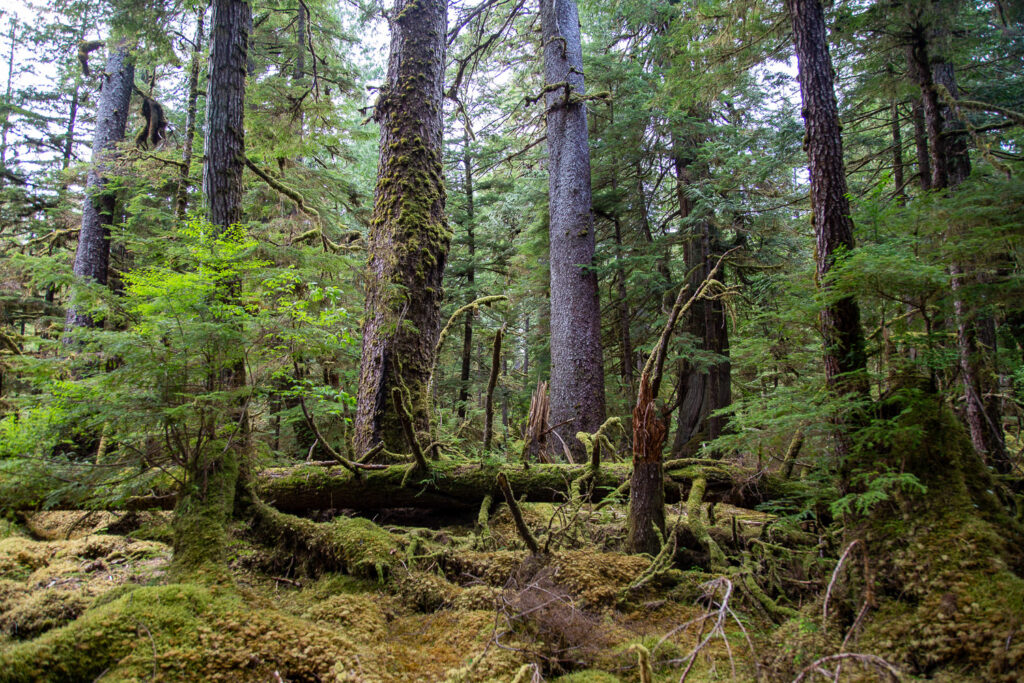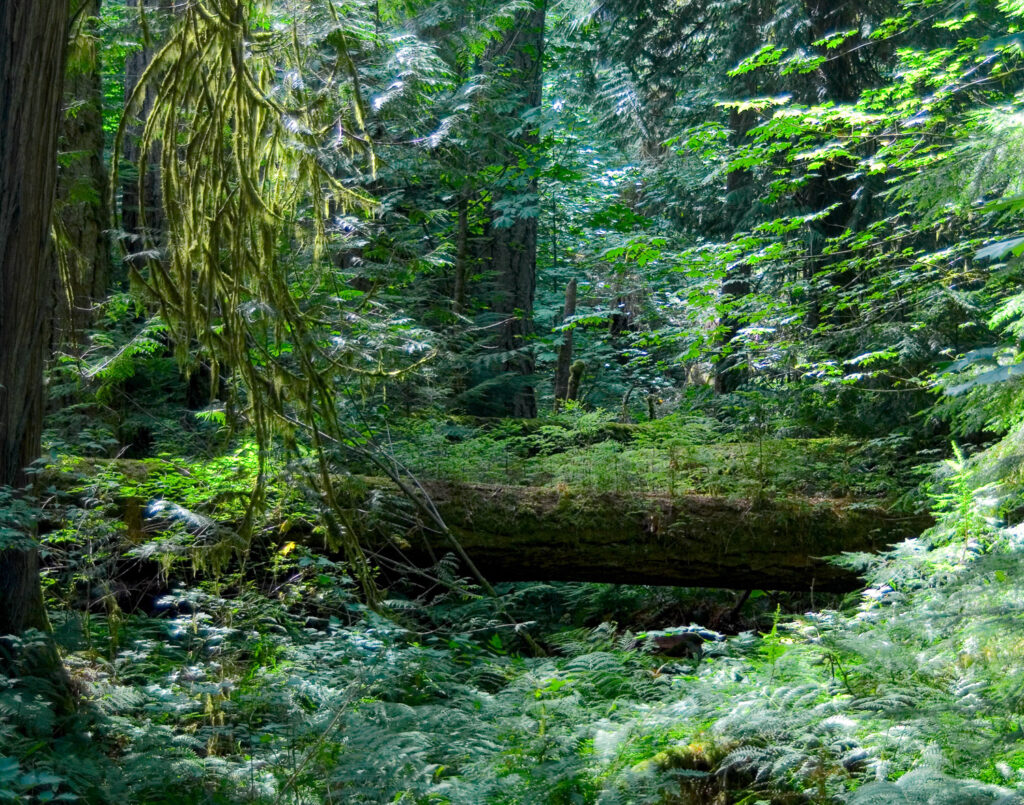Structure and Composition
Highlights
- Old growth differs significantly from younger growth in structural and compositional attributes that include a multi-aged and multi-layered canopy, horizontal patchiness with canopy gaps, numerous large snags and logs, two or more tree species, wide uneven tree spacing, hummocky microtopography of the forest floor, and increased understory production. In comparison, forests initiated by forest harvesting and planting of a single tree species are often relatively simple and homogeneous in structure and composition
Overview
Old growth forests are complex natural systems, in which all parts are connected, and death is as important as life in sustaining the system. At the time a tree dies, it has only partially fulfilled its potential ecological function. Live trees provide source material for the other key structural components of old growth forests including snags, logs on the ground, logs in streams and the forest floor.
Old growth differs significantly from younger growth by structural and compositional attributes that include large old living trees, a wide range of tree sizes and ages, a multi-layered canopy, horizontal patchiness with canopy gaps resulting from the mortality of single or small groups of trees, numerous large snags and large diameter long downed logs, two or more tree species, wide uneven tree spacing, hummocky microtopography of the forest floor, and increased understory production (Pojar et al., 1992Pojar, J., Hamilton, E., Meidinger, D., Nicholson, A. 1992. Old-growth forests and biological diversity in British Columbia. In: Landscape approaches to wildlife and ecosystem management. Proc. Second Symposium Canadian Society for Landscape Ecology and Management. Ingram, G.B. and Moss MR., eds. UBC, Vancouver, BC. pp. 85–97. More; Price et al., 2020Price, K., Holt, R., Daust, D. 2020. BC’s Old Growth Forests: A Last Stand for Biodiversity. More). Driven by gap dynamics, the forest canopy continuously renews itself and complex canopy structure is maintained (Daniels and Gray, 2006Daniels, L.D., Gray, R.W. 2006. Disturbance regimes in coastal British Columbia. B.C. J. Ecosyst. Manag. 7: 44-56. More). Old growth attributes develop faster on moist, productive sites than drier, poor sites, for example good sites develop a wider range of tree sizes earlier than poor sites (Franklin et al., 1981Franklin, J.F., Cromack, K. Jr., Denison, W., McKee, A., Maser, C., Sedell, J., Swanson, F., Juday, G. 1981. Ecological characteristics of old-growth Douglas-fir forests. USDA Forest Service, Pacific Northwest Forest and Range Experiment Station, Gen. Tech. Rep. PNW-118. More).
Live and dead trees
Trees in old growth forests are individualistic, with their characteristics shaped over the centuries by their genetics, competition with nearby trees, the effects of disturbances such as storms, diseases, and insects, and site conditions (Franklin et al., 1981Franklin, J.F., Cromack, K. Jr., Denison, W., McKee, A., Maser, C., Sedell, J., Swanson, F., Juday, G. 1981. Ecological characteristics of old-growth Douglas-fir forests. USDA Forest Service, Pacific Northwest Forest and Range Experiment Station, Gen. Tech. Rep. PNW-118. More). In contrast, many mid-seral and mature forests are dense, dark, and uniform with little understory. Those initiated by forest harvesting and planting of a single tree species can be particularly homogeneous and simple in structure and composition.
There are typically more standing dead trees (snags) and large fallen trees in old growth than in younger forests, although this depends on location and species. Snags of western redcedar can remain standing for 75 to 125 years and Douglas-fir snags typically persist for 50 to 75 years (Franklin et al., 1981Franklin, J.F., Cromack, K. Jr., Denison, W., McKee, A., Maser, C., Sedell, J., Swanson, F., Juday, G. 1981. Ecological characteristics of old-growth Douglas-fir forests. USDA Forest Service, Pacific Northwest Forest and Range Experiment Station, Gen. Tech. Rep. PNW-118. More). One special attribute of old growth forests (and natural second growth) is that they contain snags in varying stages of decay, whereas young managed stands do not.

Logs

Understory trees and plants
Tree regeneration and growth of understory plants including cryptogamsCryptogams are plants that have no true flowers or seeds and reproduce by spores. They include mosses, liverworts, and lichens. Ferns are considered advanced cryptogams because they reproduce by spores but are differentiated into roots, stems and leaves. Read more about cryptograms. More (mosses, lichens, liverworts) is facilitated within the canopy gaps of old growth forests. There is generally greater patchiness of understory tree seedlings, shrubs, and herbs in old growth forests than younger, less structurally diverse stands. This is related to an uneven pattern of openings and shaded areas as well as provision of new substrate.
